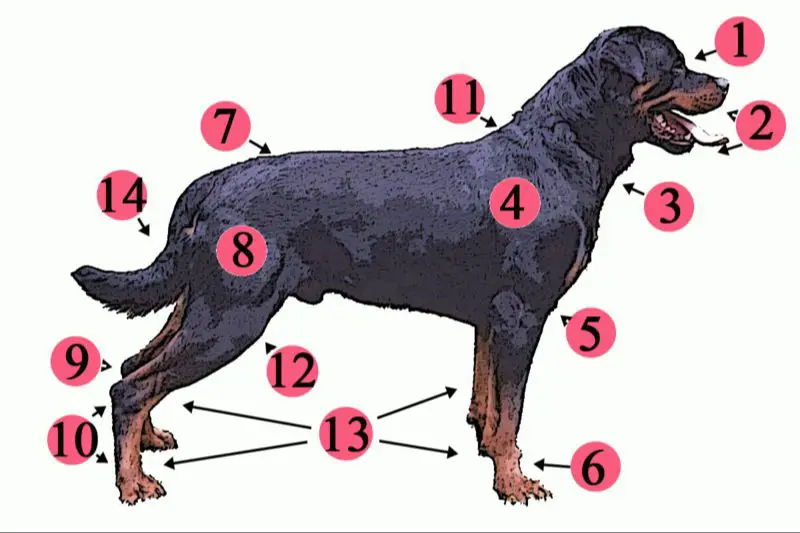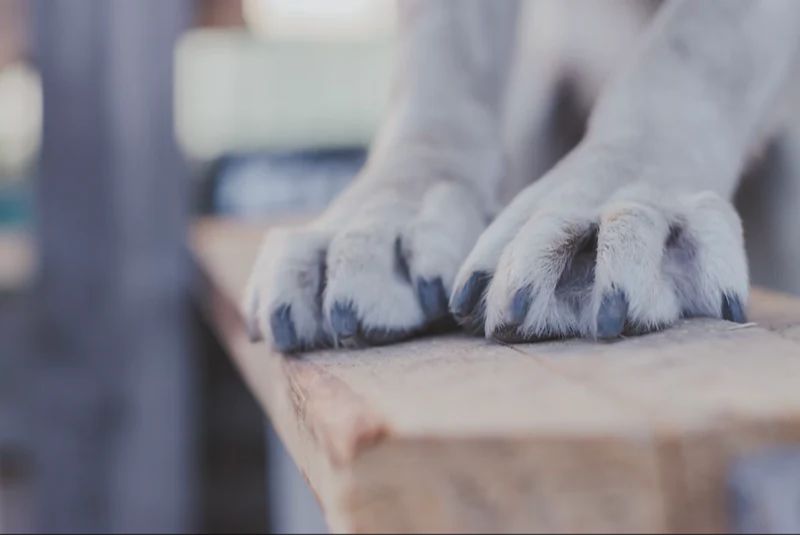Introduction
Do dogs’ paws have nerve endings? It’s a common question for dog owners who want to understand their pets’ anatomy. A dog’s paws are complex structures, equipped with nerves that allow dogs to feel sensations in their feet. This sensitivity is key for dogs’ mobility and interaction with their environment.
In this article, we’ll take a close look at the anatomy of a dog’s paw, examining the nerves and sensory receptors that allow for tactile sensation. We’ll review scientific evidence that dogs do perceive sensations through their paws. However, paw sensitivity can vary between breeds and individual dogs. Understanding your dog’s paw sensitivity has implications for training, behavior, and health.
Anatomy of a Dog’s Paw
A dog’s paw is a complex structure made up of soft tissue pads, bones, joints, veins, nerves, and other structures that allow it to support the dog’s weight and perform various functions.

The main pad on the bottom of the paw is called the metacarpal or metatarsal pad. This thick, tough pad acts as a shock absorber and provides cushioning and traction when the dog walks or runs on different surfaces. The metacarpal pad is made up of fat and connective tissue.
At the front of the paw are digital pads, one behind each toe. These pads give the toes traction and help to distribute the dog’s weight evenly across the paw. The digital pads contain fat pads and connective tissue to protect the joints and bones of the toes.
Inside the paw is an intricate network of bones called metacarpals and phalanges that form the toes. These bones provide structure and mobility to the paw and are connected by joints. Tough ligaments help hold the bones together and allow flexion of the toes.
A dog’s paw also contains veins that deliver deoxygenated blood back to the heart and arteries that distribute oxygenated blood from the heart. Sensory nerves run throughout the paw, sending information back to the brain to enable the sense of touch.
Nerves and Sensory Receptors
Like human hands, dogs’ paws contain a complex network of nerves and sensory receptors that allow them to perceive touch, pain, temperature, and more. The main types of sensory receptors in dog paws include:
- Mechanoreceptors – detect pressure, vibration, texture, and stretching of the skin
- Nociceptors – detect painful stimuli and mechanical damage
- Thermoreceptors – detect changes in temperature
These receptors are located throughout the hairy skin, glabrous skin (hairless areas), and digital pads of the paw. The highest densities are found in the digital pads and interdigital webbing between toes. Dogs have nearly 5 times as many nerve endings concentrated in their paws compared to humans’ hands.
This abundant sensory nerve supply allows dogs to perceive even delicate tactile stimuli. For example, they can feel small changes in surface texture or pressure through their paw pads. Their high density of nociceptors also makes their paws quite sensitive to pain, heat, or cold.
So in summary, a dog’s paws contain an intricate network of sensory nerves, enabling highly acute touch and pain perception similar to a human hand.
Evidence of Sensation
Dogs clearly demonstrate that their paws can sense touch, heat, cold, and pain. One of the most obvious signs is how dogs respond to their paws being touched or handled. Gentle touching usually elicits no reaction, but more pressure will make a dog pull her paw away or vocalize. Similarly, injured or irritated paws will cause dogs to limp or lick excessively at their paws in an effort to soothe the discomfort.

Thermal sensations like heat and cold also generate a response in dogs. Most dogs are curious about or avoid walking on hot surfaces like asphalt on a sunny day. They may also hesitate to step on cold surfaces or favor their paws in the winter. Reactions like these indicate their paws can feel temperature extremes. Overall, the behaviors and reactions we observe in dogs reveal that their paws have nerves that respond to tactile, thermal, and pain sensations.
Protection for Paws
A dog’s paws are protected by thick pads of fat and connective tissue that help shield them from rough terrain and hot surfaces. These calloused pads allow dogs to run and play without getting injured. While dogs do have nerves in their paws, the pads provide a layer of natural protection.
In addition, dogs tend to be stoic about physical discomfort. An owner may not realize their dog’s paws are hurt because the dog does not vocalize pain or show obvious signs of injury. Dogs in the wild could not afford to show weakness or injury, so they evolved to quietly endure issues with their paws.
Therefore, while dogs do feel sensations in their paws, the combination of calloused pads and a high pain tolerance means they can handle more than humans may expect. Dog owners still need to be mindful of hot pavement in summer, chemical deicers in winter, and rough terrain that could cause unseen injury.
Importance of Paw Health
A dog’s paws are vulnerable to injuries and health issues. With the paws containing many nerves and in constant contact with the ground, they can be easily hurt. It’s important for dog owners to watch out for signs of paw injuries or discomfort. Some common problems include torn nails, cuts, burns, cracks, bacterial infections, plant allergies, and frostbite.
Warning signs that indicate an issue with your dog’s paws include limping, licking or chewing at the paws, sensitivity to touch, redness, swelling, discharge, odor, and loss of fur between the toes. If you notice any of these symptoms, examine your dog’s paws carefully and contact your veterinarian if the cause isn’t obvious.
Regular paw hygiene and care is crucial for keeping your dog’s paws healthy. Gently wash any dirt, debris, salt, or chemicals off their paws after walks. Trim excess fur between the paw pads. Apply moisturizing balm to paws in dry or cold weather. Check paws routinely for cuts, scrapes, cracks, or foreign objects. Letting issues go untreated can lead to infection or discomfort. With some basic care and vigilance, dog owners can help keep their pet’s paws in the best possible shape.
Paw Sensitivity Varies
The amount of padding on a dog’s paw can vary significantly between breeds. Dogs like Labradors and Golden Retrievers tend to have thick padded paws, while sighthounds such as Greyhounds have very thin pads with little cushioning. The thickness and degree of keratinization of the pads definitely plays a role in sensitivity.
Beyond differences in padding, individual dogs also appear to have different sensory thresholds in their paws. One dog may recoil at walking on a hot surface, while another in the same environment seems unbothered. Some react strongly to rough terrain or cold snow, while others take it in stride.

There are also differences in sensitivity between the pads themselves and the skin between the pads. The furred skin between the pads and around the edges appears more sensitive than the pads in most dogs. However, the nose pad in particular tends to be more densely enervated than the foot pads.
Impact on Training and Behavior
A dog’s paw sensitivity can influence how it responds to paw handling and grooming. Dogs with more sensitive paws may show signs of discomfort or avoid having their paws touched. Other dogs may not react much to paw handling due to less sensitive paw pads.
Since paw sensitivity varies between individual dogs, it’s important to pay attention to your dog’s response when touching its paws. Start by briefly handling your dog’s paws and rewarding calm behavior with treats. If your dog seems distressed, take things slower and gradually build up paw handling.
For grooming like nail trims, go slow and give your dog praise and high-value treats. Make it a positive experience. Being patient and reading your dog’s signals allows you to tailor handling to your dog’s needs.
With time and positive reinforcement, you can help more sensitive dogs become accustomed to paw handling. But forcing handling or pushing too fast can make dogs more resistant. Working at your dog’s pace keeps the experience feeling safe for sensitive paws.

Frequently Asked Questions
Do dogs have feeling in their paws?
Yes, dogs definitely have feeling in their paws. A dog’s paws contain many nerves and sensory receptors that allow them to feel sensations like touch, pressure, temperature, and pain. The paw pads and skin have sensory nerves just like other areas of a dog’s body. Dogs may show signs of discomfort or pain if their paws are injured or sore.
Should I put booties on them?
Using dog booties or paw protection can be beneficial in certain situations where dogs need shielding from hot pavement, cold snow, rough terrain, salt on winter roads, or hot sand at the beach. However, booties should be sized properly and introduced gradually so they don’t cause discomfort. Not all dogs take well to wearing booties. Owners should monitor for signs of irritation and only use booties when truly needed.
What do I do about cracked paw pads?
Cracked paw pads can be painful and require treatment. Keep your dog off hot pavement in summer. Apply a dog-safe moisturizing balm to cracked pads. For deep cracks, cleaning and gently bandaging the paw may help. See your veterinarian if the cracks bleed, ooze, or don’t heal within a few days. They can prescribe medication if an infection develops. Prevent recurrence by using paw protection and keeping pads conditioned.
Conclusion
In conclusion, a dog’s paws are indeed sensitive organs filled with nerves and sensory receptors. While their tough pads and nails provide protection, they can still feel pain, temperature, and texture through their paw pads and skin. Maintaining your dog’s paw health through regular grooming and care is important, as paw issues can cause discomfort and impact their mobility.
Although paw durability varies between breeds, your dog’s paws should be handled gently and kept clean and moisturized. Be mindful that booties, salt, hot pavement, rough terrain, and neglect can all hurt your dog’s sensitive paws. Watch for signs of discomfort like limping or licking and check their paws routinely. Keeping their nails trimmed will also ensure their touch receptors aren’t constantly stimulated.
Caring properly for your dog’s paws will allow them to get the most enjoyment from walks and physical activity. Healthy paws free from injury or irritation will keep your dog comfortable and their sensory receptors functioning normally. Show your dog daily love by maintaining the sensitive but remarkably tough part of their anatomy that connects them to you and the world.